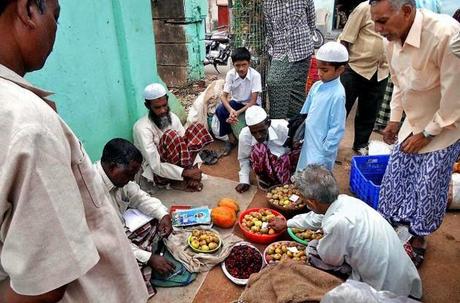By Mohammed MirzaA remote suburb amidst the metropolitan city of Hyderabad in Southern India lies a community whose residents boost of their ancestral lineage, tracing it back to Hadhramaut in Yemen. What makes the place even more special is that the community still retains its rich Yemeni culture and continues to intrigue outsiders.The place wears a cloistered look and it’s hard to spot the difference between it or any other colony in the older portion of Hyderabad, you have to dig down deeper to feel its quintessential spirit. As we were walking around the empty streets after dawn, the first disparate thing we noticed were the few men with Arabian facial features walking around the colony’s narrow lanes in a sarong.

The mystifying walled houses had Arabic scripts inscribed above their doorways and wooden windows typical to Arabia opened right into the narrow lanes, this was the first taste we had of a culture so different to ours yet intriguing at the same time. It almost felt like walking around the lanes of Arabia straight from a passage I read in the Arabian Nights.I noticed the family names start with a B (typical to the Hadramis) and a conversation with a local leads to the ultimate question “which tribe do you belong to”- Al Attas, Al Amoudi and Babaad being the common ones here.Some of the older generations across this suburb in fact are able to tell exactly which village in Hadhramaut their ancestors hail from. The older generations boastfully share stories on how the Hadrami community has contributed to the development of Hyderabad.Arabian dishes such as the Mandi (basmati rice cooked with meat or chicken), Mogdaf (spices mixed in chopped lamb organs) and Sulaimani Tea can be easily found here without much hassle. There is another dish that can’t be found anywhere across the city and is only found in this part of town, known as the Sweet Harees. A sweetened version of the typical Harees (meat cooked with crushed wheat and spices).I stood there observing a tea stall selling cawa, it completely fascinated me, something I never found anywhere in India. I saw the warm smoke slowly rising from it mildly wafting along the breeze and men standing with cawa cups in their hand having more of a preference for cawa rather tea (which is a staple amongst Indians).Barkas was a colony of the former employees of Nizams, the sovereigns of the erstwhile princely state of Hyderabad. The colony originally used to serve as the Military Barracks of the former ruler of Hyderabad – the Nizam. The modern day residents are direct descendants of Hadrami military men and bodyguards hailing from the Hadhramaut region of the then, South Arabia. The name “Barkas” is believed to be derived from the English word “barracks”.The Nizams who considered themselves agnatically descended from Arabs, trusted the tall and strongly built Arabs for their army. Arabs had been mostly recruited in their personal army. Their numbers grew and the Arabs were settled in a barracks on the outskirts of the walled and gated city of Hyderabad.Local inhabitants of Barkas say that their ancestors started arriving to Hyderabad some two hundred years ago. Earlier they were housed in a nearby village of Maheshwaram, 50 km away from Hyderabad. Later on the Nizam allotted them some land nearby army barracks. Later on, Barkas became the name of place.Wherever a Yemeni lives he/she lives like a Yemeni, clinging on to their Socio-cultural lineage. And this community at Barkas signify that. They have held on to many customs well, however most have lost an important part of their culture – their language. The older generations can speak Arabic fluently, however amongst the youth it would be a rarity to come across one who can speak Arabic fluently.
